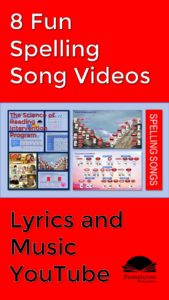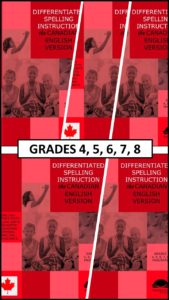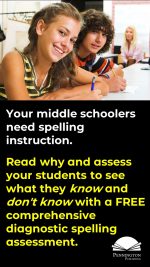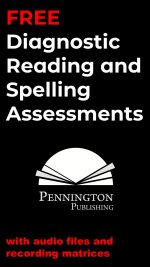
Good Readers Aren’t Always Good Spellers
Developing a weekly spelling-vocabulary plan that differentiates instruction for all of your students is a challenging task for even the best veteran teacher. Teachers truly want to differentiate spelling instruction, but the materials, testing, instruction, and management can prove overwhelming to even the most conscientious professional. Using this Spelling Program Checklist can help teachers re-focus to improve their spelling instruction.
Spelling Program Checklist
1. Instructional Challenge-Diagnostic Spelling Assessments
“Each year it’s always the same. I have good spellers and bad spellers. It takes a few weeks to find out who they are. Sometimes students will get 100%s on their Friday spelling tests, but they can’t spell anything in their writing. Unlike some of my colleagues, I do teach spelling, but I just use word lists I borrowed from a few old spelling workbooks, the Rebecca Sitton ‘No-Excuse Words,’ and words from our grade level spelling bee that we have to do in the spring. I assign spelling homework, because for some reason, spelling is about the only curricular area that parents ever ask about.”
Instructional Strategies
□ I administer, score, analyze, and differentiate spelling instruction according to a comprehensive assessment which diagnoses sound-spelling strengths and weaknesses.
□ I administer, score, analyze, and differentiate spelling instruction according to a comprehensive assessment which diagnoses sight-syllable strengths and weaknesses.
□ I administer, score, analyze, and differentiate spelling instruction according to a comprehensive assessment which diagnoses non-phonetic “outlaw word” strengths and weaknesses.
□ I administer, score, analyze, and differentiate spelling instruction according to a comprehensive assessment which diagnoses high frequency words strengths and weaknesses.
2. Instructional Challenge-Remedial Spelling Students
“Rafael is one of my brightest students, but poor spelling inhibits his writing. He just can’t get down on paper what he wants to say. Rafael continually makes the same spelling mistakes in his writing, now matter how many times I red-mark them. Memorizing the list of weekly spelling words has never helped Rafael improve his spelling; year after year, he has lagged further and further behind his classmates.”
Instructional Strategies
□ I know exactly what Rafael’s spelling deficits are, according to diagnostic data.
□ I have an instructional plan in place to remediate Rafael’s deficits.
□ I pull aside groups of remedial spellers that share a common spelling deficit for practice and spelling dictations regarding that spelling deficit at least twice per week.
□ I have formative assessments in place to analyze Rafael’s progress.
3. Instructional Challenge-Accelerated Spelling Students
“Kenny is a precocious student who clearly has a knack for spelling. On his Monday pretest, Kenny rarely misses any words. I give him the challenge words from the spelling workbook, but Kenny usually knows how to spell these too. Kenny rarely makes spelling mistakes in his writing because he selectively avoids using difficult spelling words.”
Instructional Strategies
□ Beyond the grade level spelling curricula, I know exactly what Kenny’s spelling deficits are, according to diagnostic data.
□ I have an instructional plan in place to remediate Kenny’s deficits.
□ I assign advanced spelling practice for accelerated spellers like Kenny.
□ I have formative assessments in place to analyze Kenny’s progress.
4. Instructional Challenge-Spelling Tests
“On Monday’s spelling pretest, one-third of my students get most all of the words right; one-third of my students get most all of the words wrong; and one-third of my students get about half of the words correct. I give the same test on Friday. Those who study, get an easy A; those who don’t wind up getting about the same score as on their pretest.”
Instructional Strategies
□ I use the spelling pretest as a diagnostic test and differentiate instruction from that data.
□ My spelling pretest has clear sound-spelling or syllable-spelling patterns and I analyze diagnostic data according to these patterns.
□ My spelling posttests are all individualized because they are designed according to the diagnostic data of the spelling pretest and other diagnostic assessments.
□ My spelling posttest includes words that students have misspelled in their own writing.
□ My spelling posttest includes words that student have misspelled on their last spelling posttest.
□ My spelling posttest includes non-phonetic “outlaw words” that are unknown to the students according to diagnostic data.
□ My spelling posttest includes conventional spelling rules.
5. Instructional Challenge-Spelling Practice
“I use a few workbook pages that I’ve found that go with the word lists. Sometimes I use “Puzzlemaker” to create a word search. Sometimes I have the students quiz each other on their word lists. I’ve tried spelling sorts, but they don’t work with the random word lists that I use. I assign spelling practice for homework because the parents like it, and because I can save time in class for other instructional activities.”
Instructional Strategies
□ I give my students different spelling practice, according to their diagnostic strengths and deficits.
□ I teach parents (elementary school) how to help their students practice their spelling.
□ I have students practice their spelling deficits in the context of real writing.
□ I teach students how to memorize spelling words for the spelling posttest.
□ I teach students how to use mnemonic devices to memorize difficult spelling words.
6. Instructional Challenge-Spelling Rules
“The only spelling rule my students know is the ‘i before e’ rule and the one about ‘change the y to i and add “es”,’ although they get the rules mixed up a bit. Oh, and they also know some of the plural spelling rules. Frankly, I’m not sure I could name any others. I don’t know which ones are worth teaching and which ones are not.”
Instructional Strategies
□ I teach students the most-useful eight conventional spelling rules.
□ I have students memorize the most-useful eight conventional spelling rules.
□ I have students practice the most-useful eight conventional spelling rules.
□ I hold students accountable for correctly spelling words in their own writing that follow already-introduced spelling rules.
7. Instructional Challenge-Writing
“I was taught not to red-mark any spelling mistakes because this would irreparably damage a student’s self-esteem. I’ve also heard that spelling is just an editing skill that should be reserved until the last step of the Writing Process, if there’s time. Sometimes, I do make the students write out their spelling words in complete sentences. I’ve also make them write out each word twenty times. Practice does make perfect.”
Instructional Strategies
□ I have a plan in place to hold students accountable for correctly spelling already tested words in their daily writing.
□ I mark spelling errors in student writing, according to the abilities of the individual student and hold students accountable for correcting, practicing, and applying words that I mark.
□ Students keep track of unknown or challenging spelling words that they use in their writing.
□ I teach spelling editing skills in the context of authentic writing tasks.
8. Instructional Challenge-Integrated Spelling and Vocabulary
“I usually have students define their spelling words or put the vocabulary words that I pre-teach before each short story on their weekly spelling test. Sometimes I use “Puzzlemaker” to create a crossword puzzle.”
Instructional Strategies
□ I integrate spelling and vocabulary by using derivational spellings.
□ I integrate spelling and vocabulary by using etymological spellings.
□ I integrate spelling and vocabulary by using homophone (sounds the same, but spelled differently) spellings.
□ I integrate spelling and vocabulary by using homograph (spelled the same, but sounded differently) spellings.
□ I integrate spelling and vocabulary by using Greek and Latin prefixes, suffixes, and roots.
9. Instructional Challenge-Integrated Spelling and Reading
“Most of my good readers are good spellers, but this isn’t always so. Some of my students say that they learned to read with phonics instruction; some of them say that they just memorized a lot of the words; others can’t remember how they learned to read. Maybe by being exposed to lot of correctly spelled words in reading, students will pick up spelling skills by this modeling.”
Instructional Strategies
□ I show how the phonics rules and help inform spelling decisions.
□ I teach students that spelling is an auditory skill, and not a visual one.
□ I teach phonics rules to those who demonstrate diagnostic deficits.
□ I teach structural analysis skills, including syllable rules and accent placement.
10. Instructional Challenge-Instructional Time
Elementary: “My administrator says we all have to teach spelling, but we have to have two hours of reading, one hour of math, one hour of social studies and science, and a few minutes of physical education. There just isn’t room for spelling-not to mention art, music, or critical thinking skills.”
Secondary: “My administrator says that spelling is a state and district standard and so we all have to teach it in our ELA classes to prepare for the high school exit exams. I didn’t become an English teacher just to teach spelling. There’s not enough time for novels as it is. Something just has to go and, frequently, it’s spelling. ”
Instructional Strategies
□ I spend at least one hour on spelling-vocabulary word study per week, in addition to vocabulary-in-context reading activities.
*****
A Model Grades 3-8 Spelling Scope and Sequence

Differentiated Spelling Instruction
Preview the Grades 3-8 Spelling Scope and Sequence tied to the author’s comprehensive grades 3-8 Language Strand programs. The instructional scope and sequence includes grammar, usage, mechanics, spelling, and vocabulary. Teachers and district personnel are authorized to print and share this planning tool, with proper credit and/or citation. Why reinvent the wheel? Also check out my articles on Grammar Scope and Sequence, Mechanics Scope and Sequence, and Vocabulary Scope and Sequence.
FREE DOWNLOAD TO ASSESS THE QUALITY OF PENNINGTON PUBLISHING AMERICAN ENGLISH AND CANADIAN ENGLISH SPELLING PROGRAMS. Check out these grades 3-8 programs HERE. Administer my FREE comprehensive Diagnostic Spelling Assessment with audio file and recording matrix. It has 102 words (I did say comprehensive) and covers all common spelling patterns and conventional spelling rules. It only takes 22 minutes and includes an audio file with test administration instructions. Once you see the gaps in your students’ spelling patterns, you’re going to want to fill those gaps.
Get the Diagnostic Spelling Assessment, Mastery Matrix, and Sample Lessons FREE Resource:

Literacy Centers, Reading, Spelling/Vocabulary, Study Skills
differentiating spelling instruction, high frequency spelling words, Mark Pennington, sound-spellings, spelling diagnostic data, spelling instruction, spelling lists, spelling program, spelling rules, spelling words, spelling workbooks, spelling worksheets, teaching spelling
 Introducing the Eight Great Spelling Song audio files and YouTube video links to 8 memorable songs. Help your students (and you) remember and apply the spelling rules in their writing. Turn ’em up! Your kids of all ages will love these. By the way, your upper elementary and middle school students still need spelling instruction. Don’t believe me? Administer my Diagnostic Spelling Assessment and you’ll change your mind. The assessment pinpoints each spelling pattern deficiency.
Introducing the Eight Great Spelling Song audio files and YouTube video links to 8 memorable songs. Help your students (and you) remember and apply the spelling rules in their writing. Turn ’em up! Your kids of all ages will love these. By the way, your upper elementary and middle school students still need spelling instruction. Don’t believe me? Administer my Diagnostic Spelling Assessment and you’ll change your mind. The assessment pinpoints each spelling pattern deficiency.










